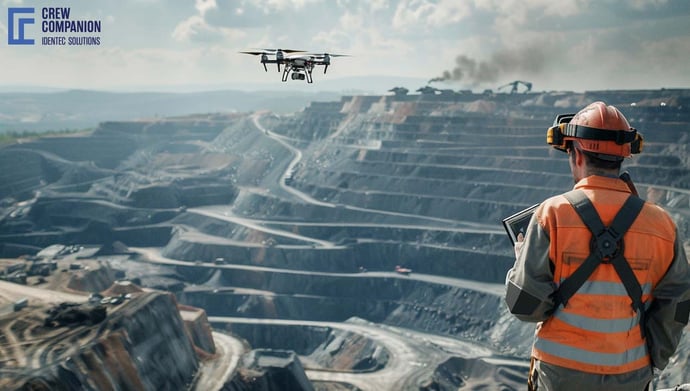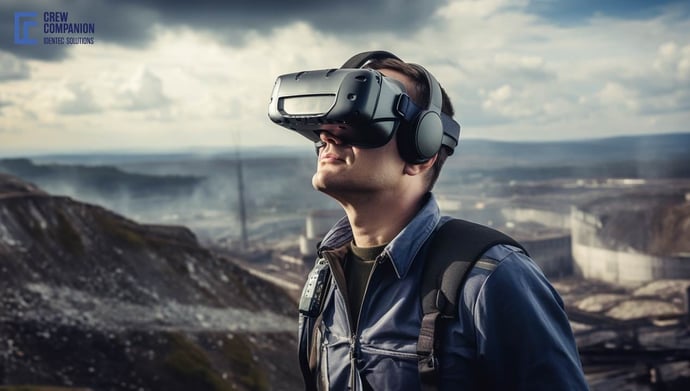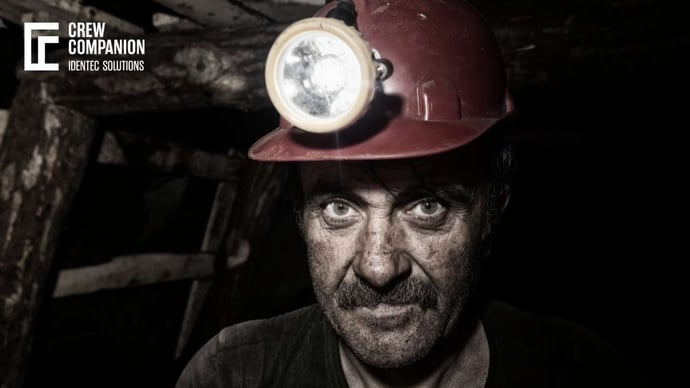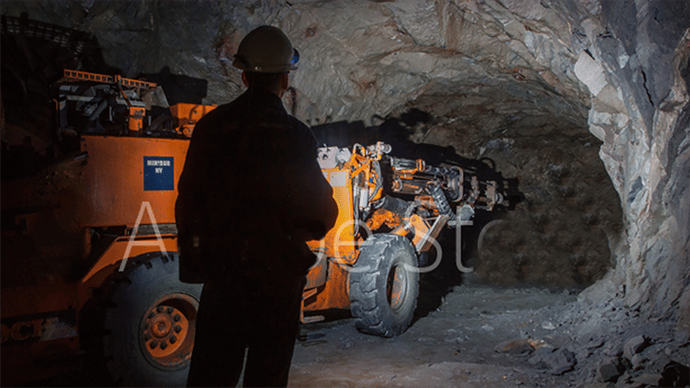Mining safety equipment and fire protection
| Written by Michal Wozniakowski-Zehenter
The dangers of working in underground mining operations are not just limited to the job's physical demands. The combination of cramped spaces, limited ventilation, and powerful machinery creates an environment that is particularly hazardous to miners' health. In coal mining, the dust and noise generated can be overwhelming. Without adequate protective gear, miners risk permanent hearing and breathing problems due to these environmental factors.
Mining companies must minimise these risks, including providing proper respiratory masks and ear protection to their employees. By prioritising the health and safety of their workers, mining companies can ensure that their operations are sustainable and that their employees can continue to work safely for many years to come. In this article, you will learn about equipment that protects miners' safety.

No video selected
Select a video type in the sidebar.
Mining safety equipment - step by step
Thanks to advances in technology and engineering, underground mining is no longer the dangerous occupation it once was. Automated mining techniques, state-of-the-art equipment, and improved mine design have made underground mining safer. Global mine operators have also implemented strict safety procedures and health and safety standards to minimise risks and prioritise worker education and training. However, it's important to remember that safety is not a one-time effort but an ongoing process (read further about blasting safety), and regular evaluation of safety strategies is critical to ensuring the safest work environment possible.
To ensure that your safety program is effective and up-to-date, it's crucial to consider various factors, such as whether your workers are receiving adequate training and are aware of potential hazards they may face. It would help if you also considered whether your safety procedures are being followed consistently and updated regularly, keeping in mind changes in technology and mining practices. Using the latest equipment and technology can also help you maximise safety and efficiency. Finally, it's essential to review and analyse data regularly to identify areas for improvement in your safety program.
Continue reading about Mining safety training!
Mining safety equipment: all you can ... wear
Mining is a dangerous profession, and the safety of miners should always be a top priority. Personal protective equipment (PPE) is the last line of defence between miners and potential hazards, and it is crucial to ensure that workers are equipped with the right gear for the job.
Protective clothing should be durable and visible in low-light conditions and should be designed to protect against cuts, punctures, and abrasions. Work gloves are essential for hand protection and should also offer puncture and abrasion resistance. Protective footwear is also essential, with options available for strength, stability, and insulation. Hard hats and eye protection are crucial PPE items, and modern advancements like integrated face shields and adjustable features make them more effective than ever.
However, hearing protection is vital to prevent permanent hearing loss due to machinery, tools, vehicles, and blasting in confined spaces. Respiratory protection is also necessary to avoid harm from dust exposure, flying particles, and grinding residues. All mine workers should have access to face masks, respirators, or self-contained breathing equipment to ensure safe working conditions and protect their health in the long term.
By emphasising the importance of proper PPE, we can help ensure the safety of miners and create a safer work environment for everyone involved.
Learn more about Risk Management in Mining!
Mining safety equipment: Fire detection systems
Once ignited, underground mine fires can be exceedingly difficult to extinguish, with devastating repercussions for the mine, the environment, and the health and well-being of nearby communities. Attention must be paid to critical areas such as conveyor belt entries and other underground locations where combustible materials build up, as these hot spots, along with humidity and air pressure fluctuations, can adversely impact the working environment, equipment operation, and lifespan. They can also trigger spontaneous combustion, especially of coal, leading to underground mine fires. How to, then, protect yourself?
Gas detectors are a common feature in mines as they can detect the presence of dangerous gases like methane, carbon monoxide, and hydrogen sulphide, which are known to cause explosions. The gas detectors can provide early warnings, which can help the miners to evacuate the area and prevent any accidents.
Infrared detectors are another critical system used in underground operations. These devices can detect heat signatures and alert miners to potential hot spots, which can help prevent fires. The infrared detectors are particularly useful in mines where the temperature is high and the risk of fire is significant.
Video monitoring systems are also becoming increasingly popular in underground mines. These systems use cameras to monitor the mine's various areas and can detect smoke or flames, alerting the central control panel. The video monitoring systems are beneficial in mines where the visibility is low and it is difficult for the miners to identify potential fire hazards.
All these fire detection systems work in tandem with heat detectors, smoke detectors, and flame detectors to provide a comprehensive fire detection strategy that ensures the safety of underground miners. Therefore, it is vital to have an effective fire detection system in place to prevent any serious damage or injury in mining operations.
What Are the Steps of Fire Suppression?
Fire suppression systems strategically located throughout the mine are designed to detect and suppress fires in underground mining operations. These systems include sensors, alarms, and fire suppression equipment that send a signal to the central control system to initiate an alarm when smoke or heat is detected.
Various types of fire suppression agents, including water, foam, or dry chemical powder, may be used depending on the nature of the fire and the specific mining environment. Additionally, ventilation controls and communication systems are integrated into the fire suppression system for efficient management of smoke and toxic gases and to enable miners to communicate with the surface in the event of an emergency.
Regular maintenance and testing of fire suppression systems in underground mines are vital to ensure their effectiveness in emergencies and to ensure the safety of miners and the protection of the mining operation from fire damage.

Mining Safety Equipment: Practice makes perfect
Without a doubt, emergency evacuation procedures are one of the most crucial aspects of underground mining safety. These procedures are designed to ensure that all miners can quickly and safely evacuate the mine in the event of an emergency. Whether it's a fire, gas leak, or collapse, every worker must know the proper steps to take to avoid injury or even death.
Regular training on these procedures is necessary to guarantee that all workers are well-prepared. Mine management is responsible for ensuring that every worker is thoroughly trained and equipped with the knowledge and skills necessary to evacuate the mine safely and efficiently. This training should include both theoretical and practical components, such as classroom instruction, drills, and simulations.
Moreover, it is essential to have a concise and clear emergency evacuation plan in place that outlines the steps to be taken in the event of an emergency. This plan should be communicated to all workers, and regular drills should be conducted to ensure that all workers are familiar with the plan and can execute it effectively.
In conclusion, emergency evacuation procedures should not be taken lightly in underground mining. Therefore, all workers must be trained on these procedures, and regular drills and simulations should be conducted to ensure that everyone is prepared in case of an emergency. Doing so minimises the risk of injury or loss of life, and workers can feel confident and safe while working in the mine.
HOw to Enhance Mining Safety Through Advanced Communication Systems?
The other major part in mining safety equipment is the implementation of advanced communication systems within a mining infrastructure. Effective communication during an emergency can mean all the difference between survival and death. Underground mines have complex tunnel structures and isolated workplaces that call for reliable communication systems that are strong enough to handle rough conditions and continue working when they are needed most. Modern mining operations are integrated with wireless communication networks in which people and equipment are traced in real-time. These systems not only support day-to-day operations but are also critical in coordinating emergency responses, such as a mine collapse or mine fire, whereby these communication systems rapidly relay information to rescue teams on the location of trapped miners and conditions. This anticipates incorporating communication systems with safety monitoring equipment, such as gas-sensing and ventilation controls which connect automatic mechanisms for alert and reaction. The integration thus assures speedy identification and mitigation of hazards, thereby reducing the potential danger of accidents. Technology will continue advancing, and so will the opportunity for the use of more refined communication tools in mining, a process which will increasingly make mining much safer. Implementing these systems testifies to the industry's commitment to improving the safety and protection of life for those working in some of the world's most challenging working environments. In prioritizing effective communication, mining companies can indeed ensure a much safer workplace—one where the risks of accidents are very low—and workers are able to equally bolster much greater confidence.
FAQs
What is the major cause of fires in underground mines?
A variety of factors can cause mine fires, but the most common ones include flame cutting and welding operations, friction, electrical shorts, mobile equipment malfunctions, and spontaneous combustion. These fires not only threaten workers' lives but also put the entire mine at risk. Therefore, measures must be put in place to prevent fires from occurring. This can include regular maintenance of equipment, proper training of workers, and installing fire suppression systems. By taking these steps, we can ensure that the health and safety of mine workers is protected and that the mine can continue to operate safely and efficiently.
What are the most common mining accidents?
Mining is a dangerous profession, and it is crucial to understand the reasons behind mining accidents to prevent them from happening. Among the most common causes of mining accidents are methane and coal dust explosions. These types of accidents have caused the most devastating accidents in mining history, with the two worst accidents each claiming over 1,000 lives. The methane contained within coal mines can be ignited if proper safety measures are not taken, leading to explosions that can cause significant damage and fatalities. Therefore, it is essential for mining companies to prioritise safety protocols and ensure that all workers are properly trained and equipped to prevent these types of accidents from occurring. By taking the necessary precautions and investing in the safety of their workers, mining companies can help to prevent these tragic accidents and protect the lives of their employees.
TAKEAWAY
Despite the progress the mining industry has made in terms of safety, it is still one of the most hazardous industries in the world. Accidents and fatalities still occur, and mine operators must take the necessary measures to protect their workers. This can be achieved by investing in the latest safety equipment and technology and providing regular safety training to all employees. Adhering to best practices and regulations is also crucial in maintaining a safe work environment. By doing so, not only do mine operators ensure the well-being of their workers, but they also improve the industry's reputation and profitability. In the end, the mining industry must strive for safety excellence to ensure that all workers return home safely at the end of each day.
Dive deeper into one of our core topics: Mining Safety
Glossary
Respiratory protective equipment (RPE) - is the name given to equipment that is specifically designed to protect your respiratory tract - including your lungs. RPE requirements will vary from site to site and shift to shift, depending on the type of mine. Each underground coal miner must have a self-contained self-rescuer (SCSR), also referred to as a closed-circuit escape respirator (CCER) unit. (2)
Sources:
(2) https://tinyurl.com/3tckmaa7
Note: This article was updated on the 13th of January 2025

Author
Michal Wozniakowski-Zehenter, Marketing Manager
Michal Wozniakowski-Zehenter is an experienced marketing and project management professional. He spent most of his career on projects with a strong focus on digital marketing and event management. He is a very active voice representing offshore and mining industries through social media channels. Michal writes mainly about offshore oil and gas, renewable energy, mining and tunnelling. Compiling and sharing the knowledge within industries is one of his goals.





